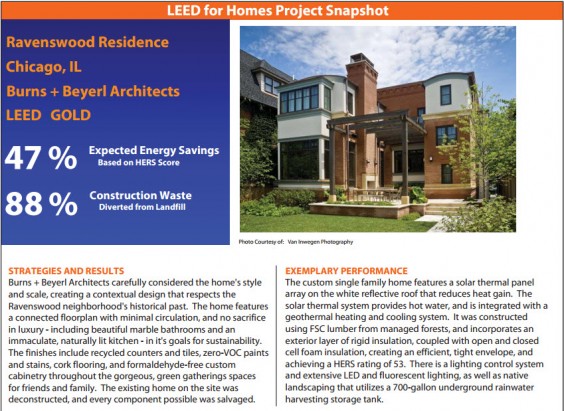
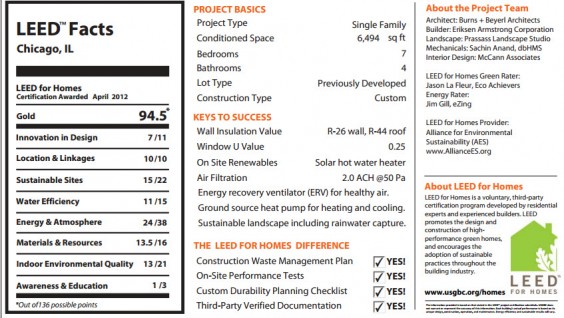
More project Details & Design Firm: http://www.bbaworld.com/pages/Press/Press-Releases/LEED.html



More project Details & Design Firm: http://www.bbaworld.com/pages/Press/Press-Releases/LEED.html
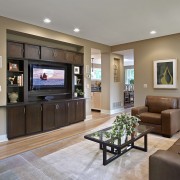
** Update 9/15/2013 – This home is about to go back on the market – If you are interested is learning more now please contact the homeowner below.
Scott Phillips, Associate at The Inovo Group and homeowner of Ann Arbor’s 1st LEED Certified Platinum Home is a passionate blogger about the success of green his certified home. Scott gives us a unique perspective of his home that was certified back in 2008. Beyond the requirements of LEED, Scott has installed 15kWs of Sunpower PV panels on his house and they have been near net-zero energy over the five month period since the install.

This video is a description of the benefits of living in a green home by the homeowners of 723 Spring Street, Scott & Linda Phillips. They discuss the positive life-style changes as well as the advantages of “living local” near down-town Ann Arbor. Scott and Linda talk about needing fewer cars, water conservation, indoor air quality and their aspiration to be a net-zero energy home soon.
“The project team started with a broad set of goals. Since these were spec homes, they needed to have market appeal – more square footage than the smaller homes in walking distance to downtown. At the same time, they needed to minimize footprint so that the lot would have lots of green space and areas for water infiltration. By building up and taking advantage of the long East/West axis of the lot, each home would have roof space to hold enough solar panels to go net-zero. By creating open floor plans, the small footprints of the homes would be spacious and feel larger. Durability and excellent thermal performance would be addressed through a combination of Structural Insulated Panels (SIPs) and Insulated Concrete Forms (ICFs). The HVAC systems in the house would augment that performance and use the least amount of energy for the structure. To the extent possible, the significant non- invasive trees on the lot would be preserved. One last goal was to have the home fit in the neighborhood of older homes. By staggering the homes, we created more solar-gathering opportunities, and decreased the mass of the homes at the street. This helped the homes appear to be in scale, and by designing for the Victorian era, we were able to build in details that were similar to surrounding homes.”
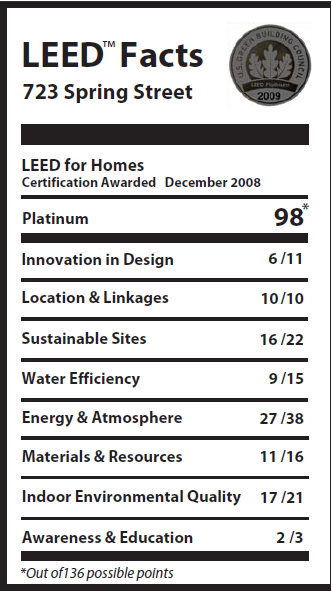
“The location of our homes, downtown Ann Arbor, contributes significantly to the owners being able to live a low-carbon and healthy lifestyle. The homes are also very tight, and our duct leakage was virtually zero when tested before drywall. Good low-flow water fixtures and recirculating hot water save operational costs, as does the geothermal system. South side windows are 3 times the area of north-facing windows, and an ERV keeps the air fresh when the windows are closed.”
Builders: Meadowlark
You can follow along the journey and continued green success of the home at the follow websites…
The web-enabled Enphase Enlighten Monitoring constantly collects real-time PV system data transmitted from the PV system.
http://pinterest.com/
Complete project profile can be viewed here


The LEED 2012 third public comment period will remain open until Tuesday, March 27 at 9am ET. Stakeholders interested in submitting comments may continue to do so through the online public comment tool available at www.usgbc.org/leed2012.

All comments will be reviewed and provided a response from USGBC. Per the LEED Foundations Documents, any subsequent substantive technical changes will be open for comment by USGBC stakeholders prior to the opening of the ballot period from June 1 – 30, 2012. Please note that feedback received after March 27, 2012 at 9:00am ET will not be provided a formal response from USGBC and may not be considered prior to the next phase of the rating system development process.
We thank you for your commitment to high performance green building standards and encourage you to continue to participate in LEED rating system development.
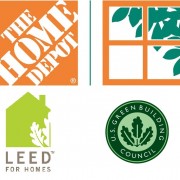
The Home Depot and U.S. Green Building Council Launch New Database of Green Building Products
leedhomedepot.com offers information on products that may contribute to the requirements of the LEED® for Homes program
(Washington, D.C.) Mar. 7, 2012 – The U.S. Green Building Council (USGBC), in conjunction with The Home Depot®, has launched an online green home products database. The database: leed.homedepot.com is a special microsite withinhomedepot.com that features products geared toward green home building, many of which may contribute towards earning LEED® points and prerequisites for the LEED for Homes program, making it easier for homeowners and builders to find the products they need.
Currently, more than 2,500 products sold at The Home Depot are listed on the website.
“The LEED green building program helps homeowners measure green home performance across a range of categories, and products play an important role in achieving certification,” said Nate Kredich, vice president of Residential Development at USGBC. “This database represents just one of the many ways in which The Home Depot is advancing sustainable, efficient and healthyhomes by supporting green building and green products.”
“As the world’s largest home improvement retailer, we want to show our customers that building green can be easy and affordable,” said Lindsay Chason, senior manager of Environmental Innovation at The Home Depot. “We have innovative, environmentally-friendly products that make LEED certification simpler. Now through our partnership with U.S. Green Building Council and their LEED for Homes program, we are simplifying the process of bringing healthier, greener homes to reality.”
The green housing market is growing rapidly, having tripled since 2008.
LEED-certified homes are energy efficient, conserve water and vital resources, and integrate environmentally preferred products into the design and construction of a home. Nearly 18,000 housing units have received LEED for Homes certification, a number that has seen significant growth in recent years. Fifty percent of LEED for Homes projects are classified in the affordable housing sector, echoing a trend found in last week’s report from The National Association of Home Builders and the Wells Fargo Housing Opportunity Index (HOI). The data shows that nationwide housing affordability rose to a record level during the fourth quarter of 2011.
The USGBC and The Home Depot product database was a subject of intense interest during Modernism Week in California last month and debuted as part of the TED Conference during which Steve Glenn, CEO of LivingHomes, a LEED home builder since 2006 and the builder of the first LEED Platinum home in the nation, showcased LivingHome C6. C6 is the first affordable housing line from the pre-fabricated builder. Once sited in their final locations, C6 homes are designed to meet the requirements of the LEED for Homes rating system. The home was designed as part of a new partnership with Make It Right, a nonprofit founded by Brad Pitt and renowned architect William McDonough to build 150, Cradle to Cradle® inspired LEED Platinum homes in New Orleans’ Lower Ninth Ward. A portion of the proceeds from the sale of each C6 will help support the efforts of Make It Right.
USGBC strives to integrate the principles and practices of social and economic justice within those of sustainable building – ensuring that low-income families will maintain access to decent, safe, and affordable housing, even as society’s standards for what is decent and safe continue to rise.
Green building offers opportunities to reduce energy and resource consumption, enabling lower utility costs and critical savings for owners, funding agencies and residents alike. Green developments are also designed to offer superior indoor air quality to protect residents’ health and reduce health-care costs, and often provide better access to public transit and local amenities, decreasing the financial burden of transportation. The green home product database released with Home Depot will assist homeowners and green building professional to achieve these tenants of sustainability, health and affordability in their housing projects.
About the U.S. Green Building Council (USGBC)
The U.S. Green Building Council is committed to a prosperous and sustainable future for our nation through cost-efficient and energy-saving green buildings. With a community comprising 79 local affiliates, nearly 16,000 member organizations, and more than 167,000 LEED Professional Credential holders, USGBC is the driving force of an industry that is projected to contribute $554 billion to the U.S. GDP from 2009-2013. USGBC leads an unlikely diverse constituency of builders and environmentalists, corporations and nonprofit organizations, elected officials and concerned citizens, and teachers and students. For more information, visit www.usgbc.org, on Twitter, Facebook and LinkedIn.
About LEED
The U.S. Green Building Council’s LEED green building certification system is the foremost program for the design, construction and operation of green buildings. Over 44,000 projects are currently participating in the commercial and institutional LEED rating systems, comprising more than 8 billion square feet of construction space in all 50 states and 120 countries. In addition, nearly 16,000 homes have been certified under the LEED for Homes rating system, with more than 67,000 more homes registered.
By using less energy, LEED-certified buildings save money for families, businesses and taxpayers; reduce greenhouse gas emissions; and contribute to a healthier environment for residents, workers and the larger community. Learn more at usgbc.org
About The Home Depot
The Home Depot is the world’s largest home improvement specialty retailer, with 2,253 retail stores in all 50 states, the District of Columbia, Puerto Rico, U.S. Virgin Islands, Guam, 10 Canadian provinces, Mexico and China. In fiscal 2011, The Home Depot had sales of $70.4 billion and earnings of $3.9 billion. The Company employs more than 300,000 associates. The Home Depot’s stock is traded on the New York Stock Exchange (NYSE: HD) and is included in the Dow Jones industrial average and Standard & Poor’s 500 index.
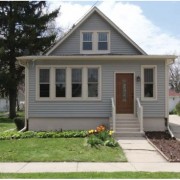
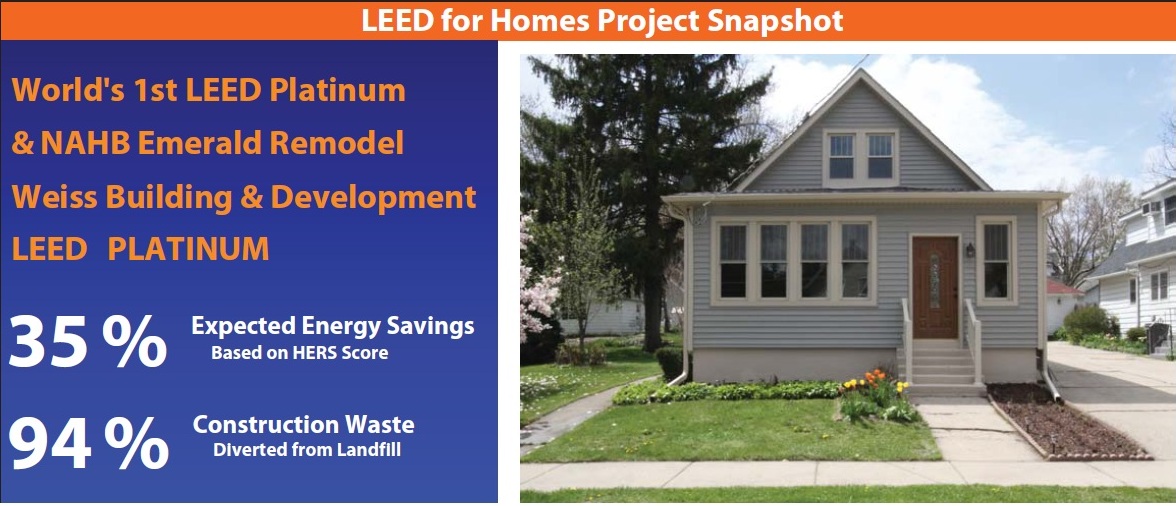
The goal of this home was to take a foreclosed home in disrepair and turn it into a high performance, healthy, utility efficient, environmentally responsible, and very durable home. Durability planning was used in conjunction with building science flashings and maintenance free exterior materials with lifetime warranties. The energy efficiency was improved by almost 300% on this home with air sealing, wall cavity insulation, exterior insulation, and windows with a .20 u factor. All materials used were non- toxic, low VOC, and had no added urea formaldehyde.
This home received two exemplary performance credits for MR 2.2. This was due to many extra points in that category for a high level of reclaimed materials usage, the use of locally produced products, and the use of low emitting products. All lumber used for framing in this house was reclaimed lumber. This remodel was done as an investment property, rehabbed and turned over and placed on the market for sale. The sales prices was comparable to other rehabbed homes in the local market. Construction costs on this project were impressively low at $55.00 per square foot.
This project was featured in the Chicago Tribune, Exerpt below.
Few homebuilding materials can’t be reused or recycled, said Brandon Weiss, president and owner of Elgin-based Weiss Building, who recently salvaged 99 percent of the material from a four-bedroom, two-bath home he rehabbed in Elgin.
“Everything that could get a second life, I donated,” said Weiss, who has become somewhat of an expert at reusing construction leftovers, filling in old crawl spaces with leftover bricks and using stones as landscaping accents.
While the tax benefits from donating construction materials are nice, it’s “our children’s future” that clinched the case for him, he said: “Our landfills are full. You can try to close that loop and reuse things.”
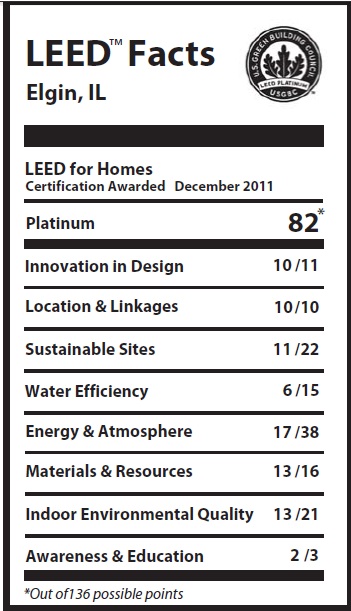
Homeowners who are planning a construction project should know that many waste companies can recycle discarded materials from trash containers and will prepare a report on the percentage of materials they are able to divert from landfills, said Jason LaFleur, regional director of the nonprofit Green Home Institute.
“If they can’t provide the service, you might want to think about going with someone else,” he said.
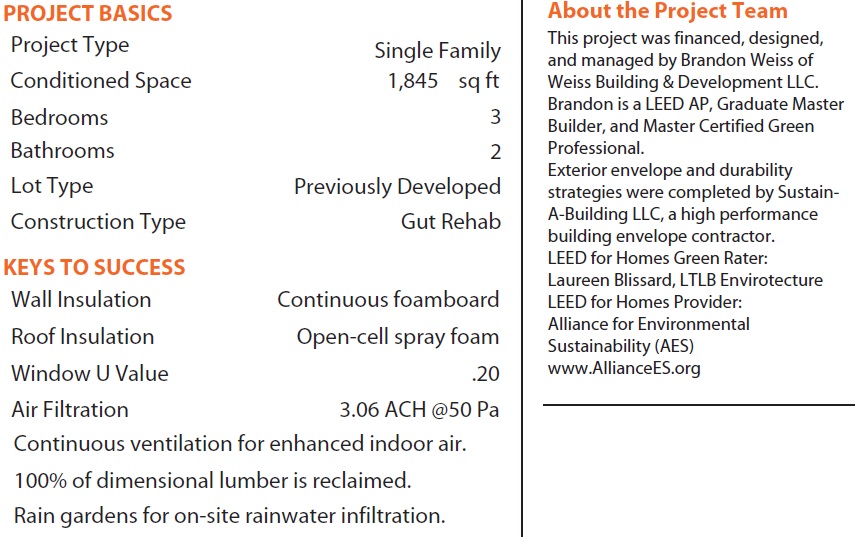
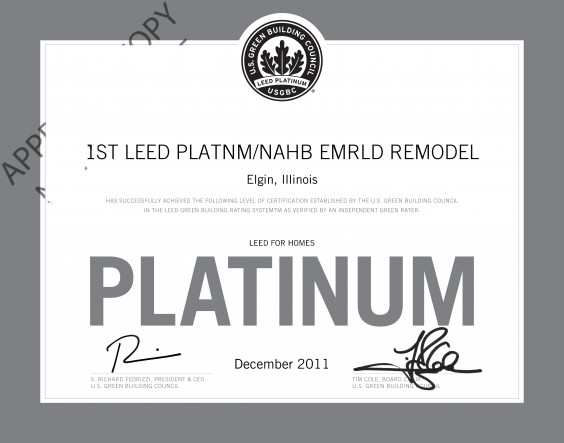
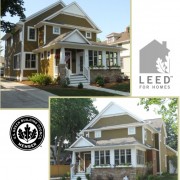
Being a LEED AP Homes and having completed almost a dozen LEED certified homes Jeremy vanEyk, Construction Manager & Vice President of Cottage
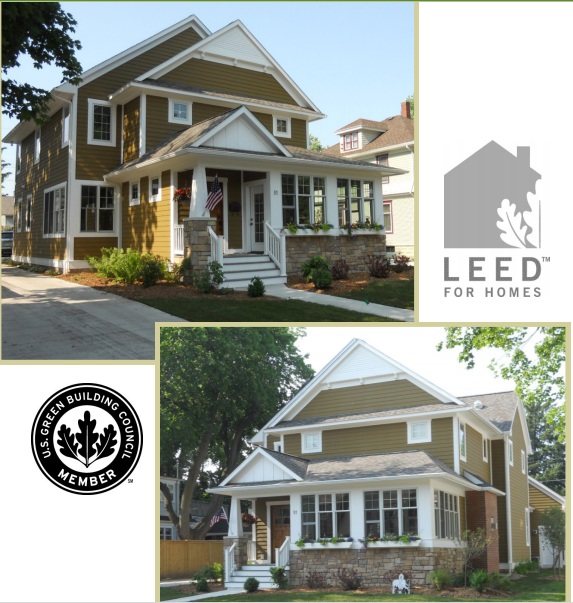 Home, has seen the benefits of what goes into a LEED home, and wanted to experience it first hand. For his family it was important to be close to the places they go the most. With the kids’ school only two blocks up the road and downtown being so close to this location, it just made sense. Working in the lakeshore environment and observing how homes react in some of the most drastic weather conditions also influenced how Jeremy chose to put the house together; choosing to go beyond building code and accepted building practices and striving to reach some of the highest standards in energy efficiency and sustainability. As it was built amongst some of the oldest homes in the city, the house needed to blend in and age as gracefully as those around it.
Home, has seen the benefits of what goes into a LEED home, and wanted to experience it first hand. For his family it was important to be close to the places they go the most. With the kids’ school only two blocks up the road and downtown being so close to this location, it just made sense. Working in the lakeshore environment and observing how homes react in some of the most drastic weather conditions also influenced how Jeremy chose to put the house together; choosing to go beyond building code and accepted building practices and striving to reach some of the highest standards in energy efficiency and sustainability. As it was built amongst some of the oldest homes in the city, the house needed to blend in and age as gracefully as those around it.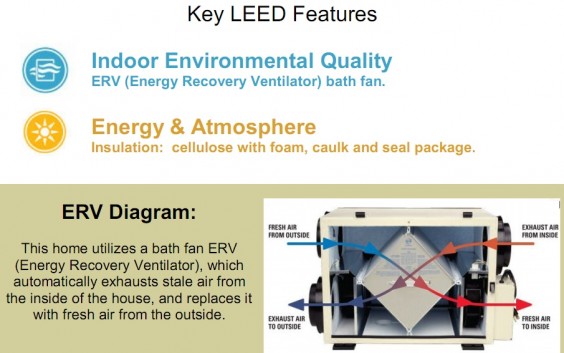
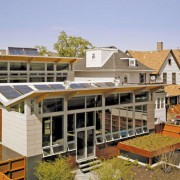
Starting with an eco-conscious dream for a truly green home transformed owner Michael Yannell’s Chicago residence into a $1.6 million, two-story 2,675-square-foot, four bedroom and two-bath Net-Zero-Energy masterpiece, producing 40 percent more energy than it consumes.
Completed in 2009, it is not only Chicago’s first LEED Platinum-certified home, but it has scored higher than any other LEED-certified project in history. Architect Farr Associates, builder Goldberg General Contracting Inc. and engineering MEP firm dbHMS created this urban infill project to utilize aspects of alternative energies through passive solar, solar grid technology, a greywater system and closed looped geothermal heating and cooling components. According to owner Michael Yannell, the main goal of this project was to create a more energy- and water-efficient, environmentally conscious place to live and to set an example by building a home as sustainable as possible. Incidentally, the green materials generally were no more expensive than conventional alternatives.
This Net-Zero-Energy residence was built using the U.S. Green Building Council’s (USGBC) LEED for Homes Pilot Program regulations. In order to earn the coveted LEED Platinum-certification, a project must meet the 100-point requirement, in which the Yannell residence scored 115.5. According to Net-Zero statistics, the Yannell residence generates 18,000 kWh/yr and uses only 12, 689 kWh/yr, earning the Yannell property an approximate $52,000 in tax credits in 2008-2009.
According to Jonathon Boyer, principal and director of architecture for Farr Associates, the permit and design processes were a challenge from the beginning, but thanks to help from a hand-picked team, deadlines were met and the project was a success.
“We put together a team of engineers, contractors, and a landscape architect, and the entire project was a team effort,” Boyer said. “Building Net-Zero-Energy is very difficult, and it requires cooperation between all components and consultants. We believe we’ve broken the sound barrier with this house, especially in the Chicago area.”
This being the first LEED-certified home came with obstacles along the way. According to Boyer, by creating new systems such as the greywater system, which recycles water used from the washing machine for the toilets, it was tricky trying to solidify the permit process. It has opened up new options for Chicago to consider when building more sustainable homes.
“It was a learning process, the city of Chicago was open to it. We didn’t have any hard and clear standards in the city for permitting this kind of system,” Boyer explained. “As a result of this house, the city of Chicago Committee of Standards and Tests is adopting a new state / city code for rainwater / greywater reuse. “We were pioneers and induced the city to think about changing permits to use more sustainable elements into the residential market,” Boyer said.
Other than utilizing alternative energies, the Yannell residence’s modern design integrated into the traditional neighborhood fuses form with function in a dense infill space. The home was built on a recycled lot where the previous building could not be salvaged. Boyer explained that typically energy-efficient homes are bland and lack style, but in this case, the owner and the building team wanted something well-designed and unique.”He [owner, Michael Yannell] wanted something aesthetically compelling and functional,” Boyer said.
The floor plan is designed as a dual-wing connected by a foyer, which acts as an entry and passageway, both equipped with south-facing windows to utilize natural light and garden views. The positioning of the wings help compete with the Midwestern climate year-round. With temperatures ranging from the high 90s in the summer to blistering zero-below winters, it was crucial to find the most sustainable design possible. Each wing has a uniquely shaped multi-functional V-shaped green-roof designed for stormwater management and for concealing the 48 photovoltaic grids on the home. “The butterfly pattern roofs are designed to screen the solar panels from view, while providing an ideal angle for the panels to harness the sun’s energy,” Boyer said.
Although the Yannell residence has received the highest LEED score, the materials it took to achieve the title are not unattainable for other eco-conscience projects. According to Boyer, “LEED for Homes is less than $3,000 for certification.” In this case, it assisted in the construction process by acting as a detailed guide when installing aspects such as air quality, water systems and when planning the positioning. Although there is no set specific standard definition for a Net-Zero- Energy home, Boyer said that there are other homes out there that claims to be Net-Zer-Energy, but many have only lowered their energy consumption. Only the Yannell property has the data to back it up. According to Principal of MEP firm dbHMS, Sachin Anand, “It’s [the Yannell residence] the future of housing and power generation where each home is a greenhouse emission-free power plant.”
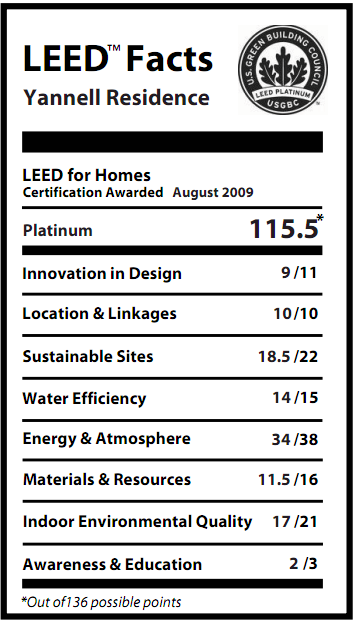
View LEED for Homes Project Profile
Photography By Christopher Barrett. Evan Lancaster is an editorial assistant at Green Homebuilder magazine. He may be contacted at elancaster@penpubinc.com.
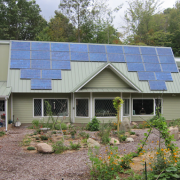
This 3-bedroom home with an attached 2-bedroom mother-in-law cottage provides living, workshop and home-office space for the homeowners and their mothers. It features barrier-free design throughout with zero-step entry, low thresholds, roll-in showers, grab bars, and knee-space under sinks and cooktops.
The super-insulated shell uses double-stud wall construction with 24,000 pounds of recycled cellulose insulation in the walls and attic, and a 6-inch layer of reclaimed foam insulation under the stained concrete floor. Heat from six flat-plate solar collectors is stored in an insulated 2,500-gallon water tank, which warms the floor and also provides most of the heat for domestic hot water.
High-efficiency wood stoves make up the balance of winter heating needs, and a small electric backup heater maintains temperatures when necessary. The home is designed to produce more electricity than it consumes on an annual basis.
The home has no lawn and is surrounded instead by gardens. The steel roof collects 2,000 gallons per inch of rainwater, which is stored in an 11,000 gallon cistern for garden irrigation and flushing toilets. A root cellar built into the hill behind the house provides zero-energy cold storage of fruits and vegetables.
As of October 2010 the Jay & Liz McClellan home officially earned a LEED Platinum rating, which is the highest of 4 levels of certification offered by the USGBC. They achieved a HERS index of 20, which one of the best in the state of Michigan.
This summarizes our energy production and consumption for calendar year 2011.
Solar electricity produced: 6033 kW h (16.5 kW h per day)
Electricity consumed: 6150 kW h (16.8 kW h per day)
Non-heating: 5350 kW h, heating: 800 kW h
Net electricity deficit: 117 kW h (-2%)
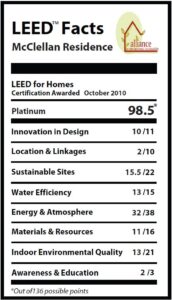
“Our first 12-month report started April 1 2010 when we first activated the PV system and went through April 1 2011, but this report covers calendar year 2011 so there are a few months of overlap. For calendar year 2011 we fell just short of our goal to produce more electricity than we consumed, with a net deficit of 117 kW h for the year. Compared to our first 12 months of operation, average daily production dropped by 0.3 kW h but consumption increased 1.8 kW h. Some of that is due to having an additional family member living here since mid-year, and some is due to adding an upright freezer that uses about 1 kW / day.”
“Below is a graph showing the inside (red) and outside (blue) temperatures that we recorded throughout the year. Overall the house was very comfortable, with just a few days in the upper 70s during some hot summer weather when allergies made us reluctant to open up the house at night since our ventilation system filters out pollen from the incoming air.”
“The graph below shows the heat storage tank temperatures over the year. The big gap is when we drained the tank due to a leak, and we were able to get the tank warmed up again in the fall but not to the degree we would have liked.”
Follow their blog at http://brainright.com/
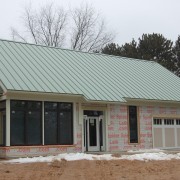
Sam Pobst has offered to host a LEED for Homes meeting and tour at his house under construction.
Sam is targeting a LEED Platinum House. He has incorporated many very efficient features. In fact, the recent blower door test came in at “0.26 ACH, the lowest reading the Green Rater, Mike Holcomb has ever had. ”
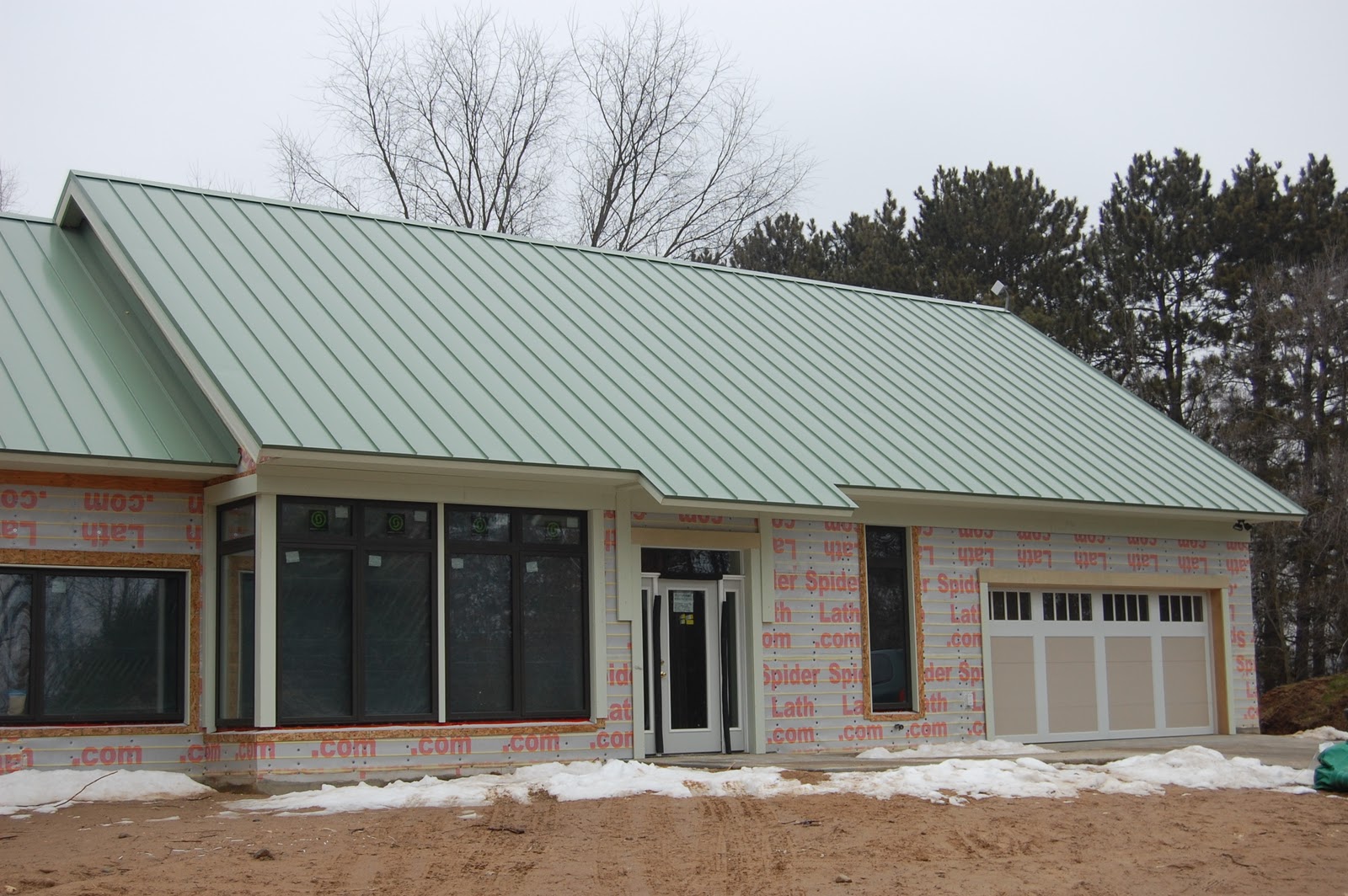
This house attempted Passive Haus certification but fell short. Many lessons are to be learned as to why it was not achieved.
MARK YOUR CALENDER if you want to see this stellar construction in process:
Date: Friday, February 3, 2012
Time: 10 am – 12 pm
Address & Info:
13691 Beckwith Drive NE
Lowell, MI 49331
Follow the project here http://sumacgrove.blogspot.com/

There are 16,194 LEED for Homes certified units in the U.S as Jan 9th. 537 have been completed by . That is about 4% of the projects!